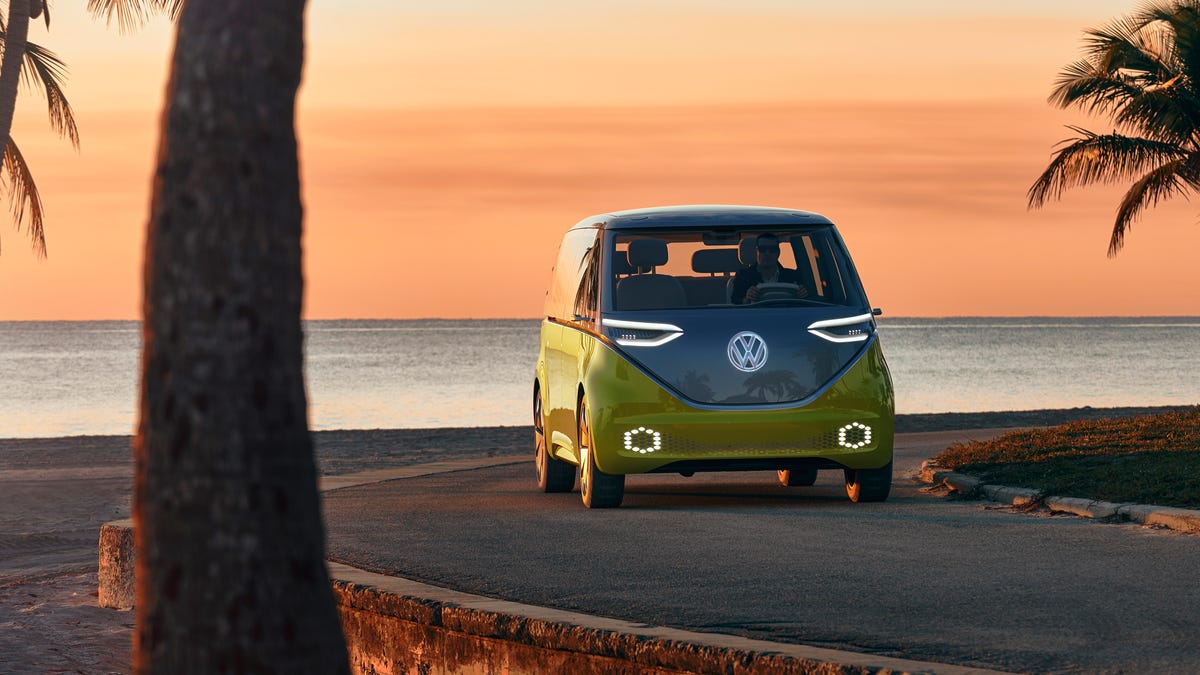Smile! VW says your autonomous electric future car looks friendlier
VW's design director says self-driving technology and car-sharing will drive more approachable-looking vehicles.

As Volkswagen stares down the same autonomous, pure-electric future mobility universe that most other companies are predicting, the German automaker sees a friendly face looking back at them.
According to Volkswagen Design Director Klaus Bischoff, concept cars like the company's new Sederic pod and ID Buzz retro bus aren't friendly looking and inherently approachable by accident. They're part of a determined strategy to disarm motorists and pedestrians alike, to charm them with kindness.
"We want to come out with a complete new design language for our electric mobility. We want to give the cars a more friendly, sympathetic appearance," Bischoff says. "They shouldn't be aggressive."
In countless surveys, consumers have expressed more than just skepticism about self-driving cars. In some cases, the concept of autonomy has been met with outright fear. Putting a literal friendly face on future automobiles could help ease minds -- consciously or otherwise -- in much the same way that Apple made desktop PCs feel friendlier with iconography, rounded forms and bright colors back with the original iMac G3 of the late '90s.
"We don't want to come up with grilles that you fear that the car eats you up. No man-eaters," Bischoff cautioned at a media roundtable at Tuesday's Geneva Motor Show.
Bischoff sees design as being particularly important for electric cars, especially in the interim while they are generally costlier than conventional internal-combustion-powered models. "They have to be attractive, [consumers] have to spend a certain amount of money more on these electric vehicles, so there should be a good reason to purchase them. Design could help to attract customers."
By virtue of their different packaging requirements, EVs present a new opportunity for designers to remake the faces of cars, in part because they don't require traditional grilles to offer cooling for radiators or other related hardware. But even if losing the hard points associated with engines, transmissions and cooling systems has given designers something of a blank slate, new autonomous sensors -- radar sensors, Lidar pucks and so on -- have conspired to create new baked-in hard points, or design borderlines.
Vehicles designed with carsharing in mind will also demand different design solutions, in part because drivers "don't have an ownership relationship to the brand," notes Bischoff. That could suggest a blander, lowest-common-denominator aesthetic could take over. Indeed, despite some illuminated facial features for communicating with pedestrians, VW's box-like Sedric concept would appear to point to exactly this sort of appliance-pod-as-transport future.
Bischoff points to the Sedric's spare, functional appearance as being a reflection of VW's German Bauhaus-inspired design aesthetic, but upon its presentation at the auto show, it struck me and a number of fellow auto journalists I spoke with as being cold and derivative.
VW's autonomous Sedric uses illuminated, face-like gestures to communicate its actions.
Of course, there are practical design considerations in this new age of autonomous EV design, too. The hidden door handles that automakers are becoming increasingly enamored with for the rear doors of today's four-door cars, for instance, will likely be a non-starter because carshare-service members may not intuitively know where to look for them.
The same logic -- perhaps even more so -- applies to vehicle interiors, where simplifying the number of controls and streamlining interfaces will be key to not overwhelming unfamiliar passengers with complex control schemes. Ease of use and proper ergonomics will be of paramount importance, even more than today.
Industry-watchers have long contended that automotive design mirrors national sentiment: The chrome-laden, pastel-painted befinned cars of the 1950s reflected the optimism of the atomic age and the space race. The cars of 2000s have been characterized by aggressive scowling front ends and high waistlines with gun-slit windows, perfect for the inward-turning, protectionist mindset fostered by our post-9/11 society.
By that logic, the promise of emissions-free mobility for all would certainly seem to support the idea of shiny, happier-faced automobiles, but motorists and pedestrians alike are going to have to get comfortable with the idea of self-driven cars first. This time, car design may have to help drive cultural sentiment, not just reflect it.

